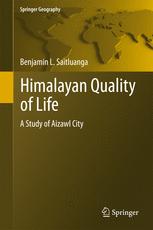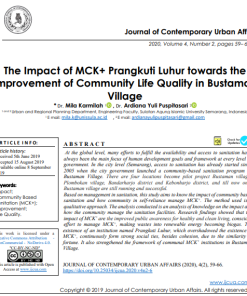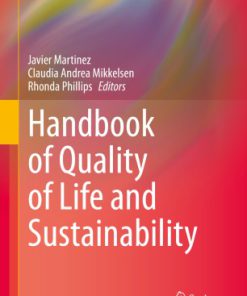Community Quality of Life Indicators Best Cases VII 1st Edition by Springer ISBN 331954618X 9783319546186
$50.00 Original price was: $50.00.$25.00Current price is: $25.00.
Community Quality of Life Indicators Best Cases VII 1st Edition by Springer – Ebook PDF Instant Download/Delivery: 331954618X, 9783319546186
Full download Community Quality of Life Indicators Best Cases VII 1st Edition after payment

Product details:
ISBN 10: 331954618X
ISBN 13: 9783319546186
Author: Springer
Community Quality of Life Indicators Best Cases VII 1st Table of contents:
1 The History, Status and Future of the Community Indicators Movement
Abstract
1.1 History of the Community Indicators Movement
1.2 Evolution of the Community Indicators Consortium
1.3 What Are “Community Indicators”?
1.4 Framing Community Indicators Projects
1.5 Situating Community Indicators Work
1.6 New Research in the Field of Community Indicators
References
Organizing Concepts and Collaboration in Community Indicators
2 The Role of Subjective Well-Being as an Organizing Concept for Community Indicators
Abstract
2.1 Introduction
2.2 Statistical and Cultural Trends of Indicator Initiatives
2.3 Quantitative, Qualitative, Objective, and Subjective
2.3.1 Subjective Well-Being
2.4 Structuring Indicator Initiatives to Be Meaningful and Accountable
2.5 Conclusion
References
3 Community Indicators and the Collective Goods Criterion for Impact
Abstract
3.1 Introduction
3.2 Why the Collective Goods Criterion?
3.3 Community Context
3.4 An Evolving History of Community Indicators in CNY
3.4.1 Using a Measurement Mentality to Set the Community’s Sight on Literacy and Education
3.4.2 Assessing Impact by TheAccrual of Collective Goods in Response to Noted Community Need
3.4.3 National Patterns
3.5 Conclusion
Appendix: Community Activities Building Toward Collective Impact in the Central New York Area
References
4 Collaboration to Promote Use of Community Indicators: Communication Is Key
Abstract
4.1 Introduction
4.2 Key Ingredients for Successful Collaboration
4.3 Case Study: Minnesota Compass
4.3.1 Collaborative Factors at Work
4.3.2 Mutual Understanding and Trust
4.3.3 Members See the Collaboration as in Their Self-Interest
4.3.4 Multiple Layers of Participation
4.3.5 Appropriate Cross-Section of Members
4.3.6 Open and Frequent Communication
4.4 Communications and Outreach: A Tactical Approach
4.4.1 Strategies and Tools
4.4.1.1 Contact List
4.4.1.2 Outreach Calendar
4.4.1.3 Communication Tools
4.5 Conclusion
References
5 Aligning Local and Regional Data to Achieve a More Inclusive Economy: A Northeast Ohio Model
Abstract
5.1 Introduction
5.2 Identifying “What Matters”: Using Data to Help Set Priorities
5.3 Pursuing “What Matters”: Establishing Shared Goals and Accountability Across Diverse Jurisdi
5.3.1 Geography Matters
5.3.2 Setting Concrete Goals
5.3.3 Tracking Progress
5.4 Toward an Inclusive Economy in U.S. Cities & Regions
References
6 Getting to Groundbreaking, but not Build Out: From Formation to Failure in a Regional Housing Indi
Abstract
6.1 Introduction
6.2 Background and Context: Housing Development Regulation in Vancouver and the Housing Affordabilit
6.3 The Inception of Getting to Groundbreaking (G2G)
6.4 Research Results and Reactions
6.5 G2G: First Launch to Network Failure
6.6 Discussion and Conclusion
6.7 Coda: The Network, Post-failure
Acknowledgements
References
Community Indicators Identifying Different Types of Disadvantage
7 Environmental Justice in Australia: Measuring the Relationship Between Industrial Odour Exposure a
Abstract
7.1 Introduction
7.1.1 Background
7.1.2 Existing Environmental Justice Methods: Advancements and Limitations
7.1.3 Odour Pollution Exposure
7.1.4 Spatial Correlation Between Polluting Facilities and Odour Pollution Exposure
7.1.5 Study Objective
7.2 Data and Methods
7.2.1 Odour Complaint Data and Pollution Data
7.2.2 Indicators of Socio-economic Disadvantage
7.2.3 Methods
7.2.3.1 Clustering Methods
7.2.3.2 Statistical Approach
7.3 Results
7.3.1 Clustering of Odour Complaint Data
7.3.2 Maps of Socio-Economic Disadvantage Indicators
7.3.3 Correlations of Odour Complaints, Polluting Facilities and Socio-Demographic Disadvantage Data
7.3.4 Comparison of Means t-Test for Areas with and Without Odour Exposure
7.3.5 Comparison of Means t-Test by Number of Odour Complaints
7.4 Discussion
7.5 Limitations
7.6 Conclusions and Implications
Acknowledgements
References
8 Addressing Disparities and Improving the System of Care for Veterans Through the Community Assessm
Abstract
8.1 Introduction
8.2 Background
8.3 Collaboration
8.4 Data Collection
8.4.1 Primary Data
8.4.2 Secondary Data
8.5 Reporting and Primary Findings
8.6 Action
8.6.1 Community Convening
8.6.2 Veterans Commission Formation
8.7 Conclusions and Lessons Learned
8.7.1 Coordination
8.7.2 Leadership
8.7.3 Program Measures
8.7.4 Communty Assessment
8.7.5 Relevance
References
9 Economic Issues for Women in Texas
Abstract
9.1 Using Data to Address Community Challenges
9.2 The Women and Girls of Texas
9.2.1 The Female Face of Poverty
9.3 Working Women, Working Families
9.3.1 Women and Wages in Texas
9.3.2 Women’s Earnings Critical Part of Families’ Earnings
9.3.3 The Wage Gap Between Men and Women
9.3.4 Why Does the Wage Gap Exist?
9.3.5 Why Does It Matter?
9.4 Education: A Pathway to Economic Security
9.4.1 Texas Women in College
9.4.2 If Women Are Making Gains in Education, Why Aren’t They Doing Better Overall?
9.4.3 Increases in College Costs Have Made the Education Pathway Steeper for Women
9.5 Child Care: A Critical Work Support for Women
9.5.1 Women and Child Care
9.5.2 Women Face Difficult Trade-Offs Between What They Earn and the Cost of Child Care
9.5.3 Child Care Subsidies and Pre-K Programs
9.6 Health Insurance: A Financial Shield for the Unexpected
9.6.1 Women and Health Insurance
9.7 Housing: The Anchor of Economic Security
9.7.1 Women and Housing
9.8 Conclusion
References
10 Comprehensive Sustainability Indicators: The Houston Sustainability Indicators Program
Abstract
10.1 Introduction
10.2 Systematic Procedure
10.2.1 Normative Component
10.2.2 Systematic Component
10.2.3 Evaluation Component
10.3 Policy Impact and Knowledge Increase
10.4 Conclusion
People also search for Community Quality of Life Indicators Best Cases VII 1st:
community quality-of-life indicators
community quality of life indicators
indicators of quality of life community medicine
what are quality of life indicators
quality of life indicators definition
Tags:
Springer,Community Quality,Life Indicators,Cases
You may also like…
Uncategorized
The Quality of European Societies: A Compilation of Composite Indicators Eduardo Bericat
Business & Economics
Computers - Programming
Politics & Philosophy
Teaching Quality of Life in Different Domains Graciela H. Tonon
Business & Economics
Himalayan Quality of Life A Study of Aizawl City 1st Edition Benjamin L. Saitluanga (Auth.)
Politics & Philosophy - Social Sciences












